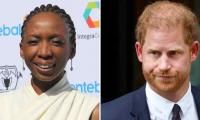coming straight from the political rally.
It was a bit of a relief in these testing times to see the love of poetry bringing together under one roof people with adversarial political views who were praising or booing in one voice the verses they collectively liked or disliked. Such shared public spaces across class, ethnicity, sectarian and party divides must be restored and encouraged.
Let me now come to the conclusions I arrived at during the conference about the state of Urdu in the present times after keenly attending a few sessions, gathering information from other delegates on sessions I couldn’t attend and after meeting with some important litterateurs and scribes of the current times.
Urdu is not going anywhere, geographically speaking and in popular imagination. The threats posed by English are digging more into the common vocabulary of Urdu language, but its verbs, phrases and syntax stay intact. In effect, the more people from across classes and secondary towns participate in media and communication, theatre and oratory, the more Urdu is used. The mushrooming of private television channels, both news and entertainment, and FM radio stations has perhaps created challenges for the right usage, pronunciation, correct idiomatic expressions, etc of Urdu but the phenomenon has promoted the language and its use like never before.
That also means that the more democracy and participation we have – which will rapidly increase the need of communication between people living in different places in the length and breadth of Pakistan – the more will Urdu be used around us. One small example is the commercial non-viability of three English-language news channels in recent years. It forced one to be shelved after years of investment and just at the time when it was all set to be launched, the other completely switched from English into Urdu and the third was shut down after running for a couple of years.
One interesting thing is that while Urdu news, drama and music channels continue to marginalise English language broadcasting, they pose little threat to the electronic media in other Pakistani languages. The more the public at large involves itself in political, cultural and social conversation, the more space is created for other Pakistani national languages.
Sindhi, Pashto, Seraiki, Hindko, Balochi and Punjabi channels as commercial enterprises may not be making as much money as Urdu channels, but they are growing and progressing incrementally. A new blend of languages is also witnessed in political talk shows as well as entertainment shows when Urdu is used intermittently on Sindhi, Seraiki and Pashto television channels. Some channels actually have bilingual programming where a couple of hours every day have been dedicated to Urdu talk shows.
What could not happen in the echelons of power, bureaucracy and parliament, educational curriculum and state-sponsored narrative, is now happening on private radio and television channels where languages are used according to the needs and demands of common citizens and also treated with equal respect.
For someone like me – who appreciates that a language whose speakers grossly outnumber its so-called native speakers – developing, agreeing to and making people adhere to a standard register, a uniform accent and pronunciation will not be possible. Therefore, the more Urdu is left on its own, in terms of people using it as they need and as they please, with the ‘Urduites’ stopping their lament about its downfall and not worrying about its imposition by the state as a national language in the true spirit, it will continue to evolve gaining strength from its sister languages and local dialects within Pakistan.
It is the lingua franca and the shared language of the people but not the mother tongue of most. Pitching it against other national languages and mother tongues of the country through half-hearted state patronage over the years has done it no good. Thank God the Pakistani state, sans the Punjab government, has largely withdrawn its patronage. My theory here, bordering on conspiracy theory of course, is that when the dominant elite realised that people have learnt Urdu and it has become a people’s language, they stopped patronising it.
However, my conclusion remains that Urdu is needed for the practical reasons of market expansion, shared social and political interests and cultural expression. Whether Bilawal speaks in Karachi or Gilgit, Sharif speaks in Lahore or Quetta, Khan s in Islamabad or Multan, Fazlur Rehman in DI Khan or Sukkur, and Dr Maalik in Ziarat or Khuzdar, they will all speak to the public in Urdu. Likewise, it will be the preferred language for all current affair analysis and news broadcasts. Urdu is not going anywhere; it is here to stay as the language of public discourse.
The other conclusion and a different meaning of the expression that Urdu is not going anywhere – as in not progressing and developing – is also true. Urdu is no more the language of intellectual discourse in Pakistan. When I shared this with some senior Urdu writers, they got truly upset. Nevertheless, I maintain that since there is no new knowledge that is generated in Urdu – from philosophy and mathematics to sociology and economics – it is not among the greatest intellectual languages of the world today.
One way of dealing with our backwardness in different disciplines of knowledge could have been speedy and quality translations of contemporary knowledge into Urdu. There was a time when this was happening but this has ceased to happen anymore for quite some time. Therefore, it is important to recognise that neither Urdu nor any other languages we speak and write in Pakistan have anything to offer to anyone from the outside world except for some pieces of literature in Urdu, Sindhi, Punjabi, Pashto or Seraiki.
Urdu may well be the most representative language of Pakistani literature but that is not enough to make a language the language of intellectual discourse.
The writer is a poet and author based in Islamabad.
Email: harris.khalique@gmail.com
Please note that dam survey team from World Bank had proposed building of this dam in 1955
Cuts in public sector development spending programme are also likely to further affect quality of essential services
Barriers and hurdles created by Trump's tariff policy have potential to disrupt smooth supply chain of trade and...
Indus Commission having failed to find solution, dispute was discussed by foreign secretaries
This demand has fueled rapid growth deposit base of Islamic Banks and Islamic Windows operated by conventional banks







